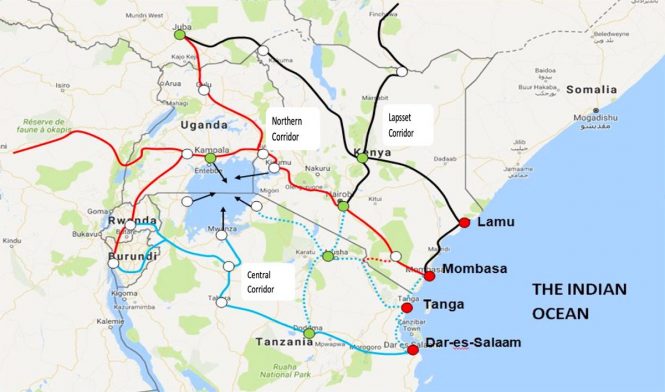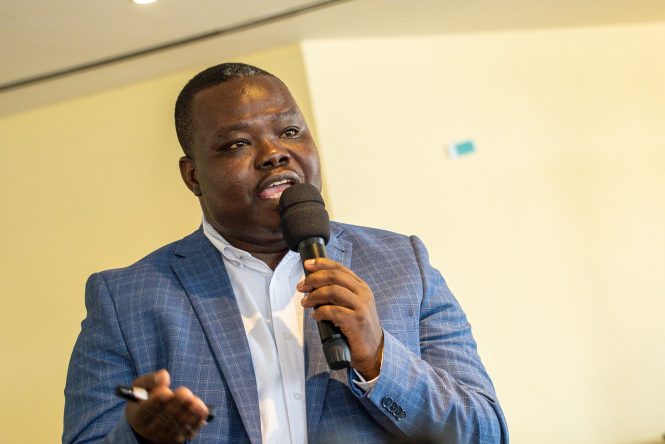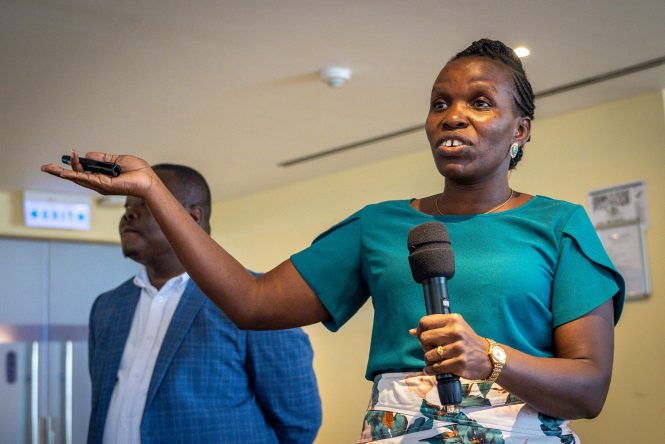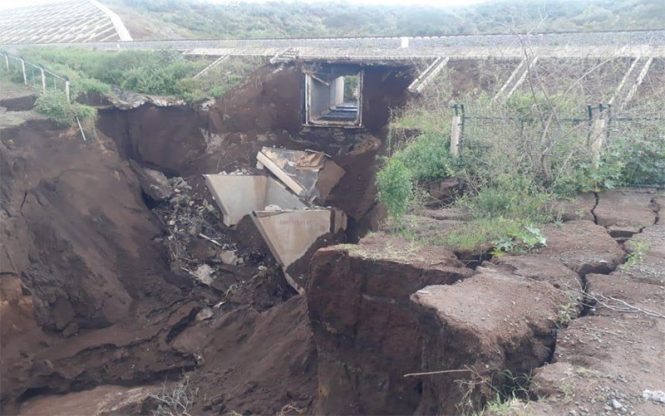
Eng. Achieng’ Akun Beatrice, Railway Expert at EAC and Eng. Godfrey A. Enzama, Head of Transport & Works and Acting Director of Infrastructure at EAC, recently represented the East African Community (EAC) at the African Union Commission (AUC)’s Department of Infrastructure and Energy (IED) Continental Workshop on the Implementation of the Africa Integrated Railways Network (AIRN), which took place from 7th to 10th May 2024 in Dar es Salaam, Tanzania.

Eng. Godfrey A. Enzama, Head of Transport & Works and Acting Director of Infrastructure at EAC
Eng. Godfrey introduced the EAC as an organisation that continues to grow and represent the region, noting the Federal Republic of Somalia as the most recent country to join the community. The EAC is a regional inter-governmental organisation comprising the Republic of Burundi, the Democratic Republic of Congo, the Republic of Kenya, the Republic of Rwanda, the Federal Republic of Somalia, the Republic of South Sudan, the Republic of Uganda, and the United Republic of Tanzania, with its headquarters in Arusha, Tanzania. The total surface area is 4.8 million square kilometres, with a population of 305.3 million (2022) and a nominal GDP of US$ 337.5 billion (2022).
The EAC strives for a prosperous, competitive, secure, and politically united East African Community. Integration is achieved through several key pillars. The journey began with the establishment of the Customs Union, which has progressed significantly. Following this, the Common Market was introduced, both of which support the EAC infrastructure programmes. The EAC also aims to achieve a Monetary Union, originally targeted for 2013, though recent adjustments have extended this timeline. Additionally, the goal of forming a Political Federation remains, with the EAC currently operating under a Political Confederation, which is a step towards this vision. The mandate for railway and infrastructure development is derived from the establishment treaty.
It is important for stakeholders in the region to understand the foundational principles behind regional infrastructure development. Infrastructure in the region is largely supported by the heads of state, the highest organ of the community. Recently, one of the heads of state made a passionate plea to advance railway development, highlighting the strong support enshrined in the treaty. Specifically, Articles 89 and 91 address common transport and communication policies. This includes integrating, developing and upgrading roads and railways, which underscores the focus on railway development. Additionally, the importance of intermodal transport systems, supporting landlocked partner states and harmonising elements is emphasised. The treaty ensures the development of common policies for railways and rail transport, including common safety rules, standards, and requirements.
For development partners to have a regional view, it is crucial for the EAC to be involved in regional projects. The EAC perspective on the African integrated high-speed railway networks includes two links: the Central Corridor and the Northern Corridor. The standard gauge development is quite unique for the East African region.
The partner states initiated SGR development, with the EAC’s involvement coming later. However, the focus was not only on individual states but also on creating the East African Standard Gauge Railway Master Plan, which adopted alignments from the first EAC Railway Master Plan developed in 2010. Some projects have successfully picked alignments from the 2010 East African Master Plan. Initially, there were only three partner states then, but now there are eight.

Eng. Achieng’ Akun Beatrice, Railway Expert at EAC
Eng. Achieng’ Akun Beatrice, Railway Expert at EAC, highlighted the railway projects within the region. On the Northern Corridor, the 472 km Mombasa-Nairobi Standard Gauge Railway, constructed by Kenya, is currently operational. Additionally, the 120 km link from Nairobi to Naivasha is also operational.
The 262 km Standard Gauge Railway line from Naivasha to Kisumu and the new port at Lake Victoria in Kisumu is currently at the finance identification stage, as is the 107 km Kisumu to Malaba section. In terms of the Malaba–Kampala–Gatuna–Kigali Standard Gauge Railway Project, financing arrangements are ongoing.
The LAPSSET Corridor projects include:
The 325 km Lamu-Mariakani link – is at feasibility stage.
The 544 km Lamu-Isiolo link – is at feasibility stage.
The 732 km Isiolo-Nakodok link – is at feasibility stage.
The 279 km Nairobi – Isiolo SGR Project – is at feasibility stage.
Significant achievements have been made in the following projects between CCTFA and Tanzania Railways Corporation;
Tanzania, Rwanda, Uganda and Burundi: Construction to SGR of the Dar es Salaam – Isaka– Mwanza and Isaka– Kigali / Keza – Gitega – Musongati
Tanzania, Burundi,DRC: Construction to standard gauge of Uvinza– Musongati– Gitega– Bujumbura/U vira– Kindu (DRC) Railway line.
Eng. Achieng’ Akun Beatrice provided insight into some challenges faced as a region, including limited private sector involvement in Standard Gauge Railway (SGR) development. SGR development is a high-cost initiative, and governments have taken the lead by borrowing, significantly impacting the debt ceilings of these countries.
Another issue is the inadequate technical capacity in construction and management. So far, only two member states have made significant progress: Kenya has developed 600 kilometres, and Tanzania is currently constructing its SGR. Other member states have limited capacity in SGR technology, which needs to change. High land acquisition costs also impede SGR development. Additionally, there is a lack of harmonised standards for interoperability. Although standards have been developed, they have not yet been adopted. Once adopted, these harmonised standards will guide SGR development.
Mobilisation of capital investment is another issue. Each country is developing SGR within its borders, and the speed of implementation depends on how quickly each member state can mobilise financing. Coordinated capital investment mobilisation could contribute to faster implementation.

Climate change risk is another major concern. Issues such as flooding and extreme temperatures are impacting railway infrastructure. Mitigation and adaptation require significant funding, and there is a need to increase the quota for climate financing, which has not been actively activated in the region. Examples of climate change impacts include eroded culverts and collapsed railway embankments, which pose significant dangers.
The main contributors to climate change impacts are global warming from greenhouse gas emissions, leading to ozone layer depletion, and uncertainty in rainfall patterns, causing heavier than normal rains. Deforestation and other land use issues also affect railway infrastructure. Potential mitigation measures include developing climate-resilient railways, creating synergy between the meteorological and railway sectors, and conducting purposeful studies on river hydrology and catchment areas. Reforestation and damming of rivers are also essential.
Climate change adaptation requires an all-inclusive approach involving stakeholders and the community. Challenges in climate financing include inadequate capacity building, lack of robust climate data, and high costs of funding requirements for climate risk mitigation and adaptation. These factors increase the capital investment needed for projects and discussions are needed to address these costs.
Recommendations on climate financing include streamlining requirements for accessing climate funds, incorporating public-private partnerships and developing affordable nature-based solutions. Capacity building on climate adaptation and mitigation, as well as improving data collection for climate modelling, are also essential. These measures will help incorporate climate resilience into railway infrastructure design.
Source link : https://www.railwaysafrica.com/news/east-african-community-advances-regional-railway-projects-amidst-challenges-and-climate-concerns
Author :
Publish date : 2024-06-09 05:49:01
Copyright for syndicated content belongs to the linked Source.





